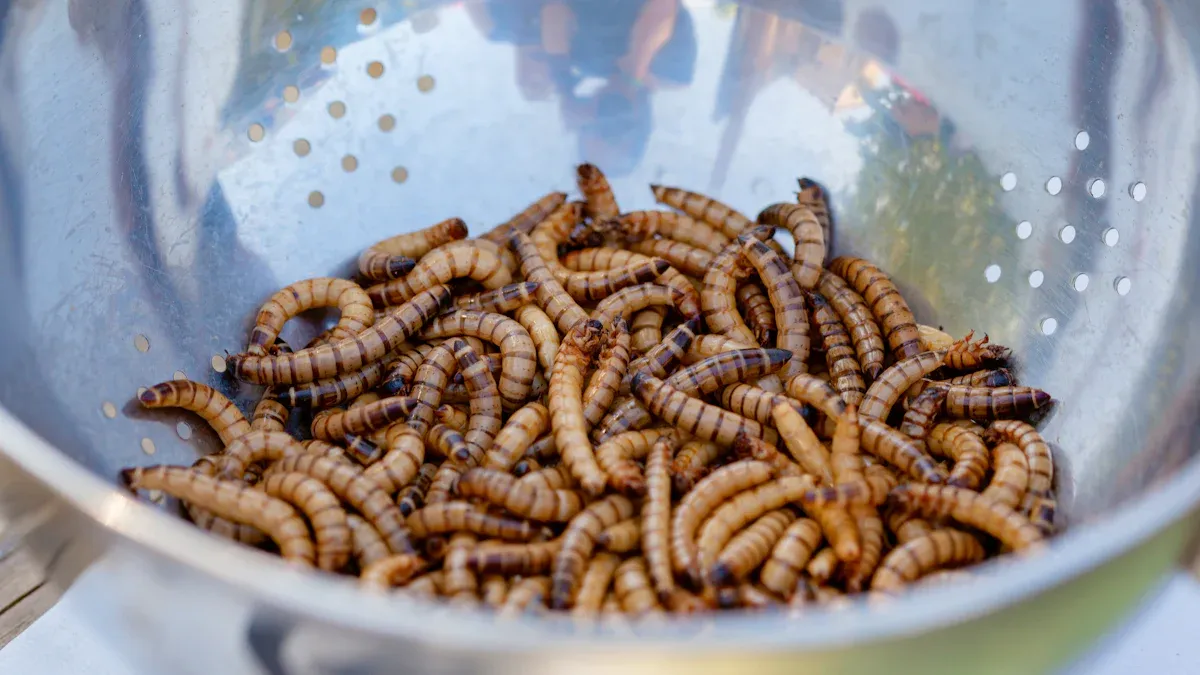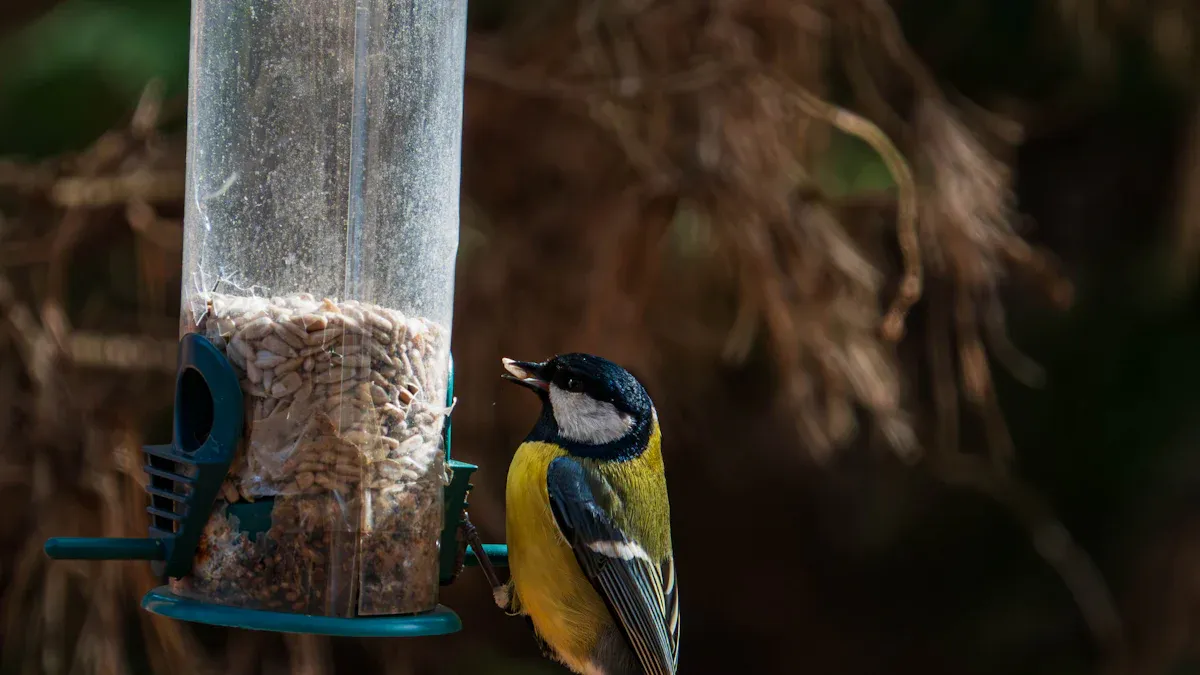
Mealworms for wild birds deliver a powerful nutrition boost, especially for robins and bluebirds. These protein-rich treats help birds grow strong during breeding and winter.
Many backyard bird lovers choose mealworms as an easy, effective way to attract more feathered visitors.
المداخل الرئيسية
- Mealworms provide wild birds with high protein, healthy fats, and fiber that support muscle growth, feather health, and energy, especially during breeding and winter.
- Offering mealworms attracts many bird species, including robins and bluebirds, making your backyard more lively and colorful.
- Use both live and dried mealworms safely by feeding small amounts, storing them properly, and keeping feeders clean to help birds thrive.
Nutritional Power of Mealworms for Wild Birds

High Protein, Healthy Fats, and Fiber
Mealworms for wild birds provide a rich source of protein, healthy fats, and fiber. Birds need protein for muscle growth, feather development, and energy. The protein content in mealworms is similar to that of crickets and higher than silkworm pupae. This makes mealworms a strong choice among insect-based foods.
| النوع الحشري | Protein Content (% dry matter basis) |
|---|---|
| Mealworm larvae | Approximately 19.4% |
| Cricket (adult) | Approximately 20.1% |
| Silkworm pupae | Approximately 14.8% |
Mealworms also contain healthy fats. About 74% of their fat is unsaturated, including omega-3, oleic acid, and linoleic acid. These fats help support heart health and reduce inflammation in birds. Fiber in mealworms comes from chitin, which helps digestion. The fiber content ranges from 6.49 to 7.97 grams per 100 grams, making mealworms a high-fiber food.
| Nutrient | Range per 100g Dry Matter | Notes on Health Benefits |
|---|---|---|
| Fat | 22.96 – 35.65 g | Mostly unsaturated, supports heart health |
| Fiber (Chitin) | 6.49 – 7.97 g | Aids digestion, classified as high fiber |
Tip: Offering mealworms for wild birds ensures they get a balanced mix of protein, fat, and fiber, which supports their overall health.
Essential Support During Breeding, Molting, and Winter
Mealworms for wild birds play a key role during the most demanding times of the year. Birds need extra nutrition when breeding, molting, or facing cold weather. Mealworms help meet these needs in several ways:
- High protein supports muscle growth and feather development.
- Essential amino acids, vitamins (B12, B6), and minerals (iron, zinc, potassium) boost immune health and energy.
- Easy digestion allows birds to absorb nutrients quickly, which is important for young birds and parents feeding nestlings.
- High fat content provides energy for flying, breeding, and staying warm in winter.
- Birds like bluebirds, robins, woodpeckers, chickadees, and orioles seek out mealworms during breeding season.
Observational studies show that birds such as western bluebirds share mealworms during winter and while raising young. This sharing helps them survive cold weather and strengthens social bonds. Birds fed mealworms during molting and winter have healthier feathers and better survival rates.
Note: Providing mealworms during these critical periods can help birds thrive and even improve their chances of raising healthy young.
Live vs. Dried Mealworms: What’s Best for Your Birds
Bird lovers can choose between live and dried mealworms for wild birds. Each type has unique benefits. Live mealworms offer moisture, protein, fat, and amino acids. These nutrients are especially important for fledglings and young birds. The movement of live mealworms also attracts birds quickly, making them a favorite for many species.
Dried mealworms have higher protein and fat per 100 grams because they contain less water. They are easy to store and serve, making them a convenient choice. Dried mealworms work well as a supplement, especially during colder months when insects are scarce. Some birds may need time to get used to dried mealworms. Moistening them can help attract birds at first.
| Type | الاستحقاقات الرئيسية | Best For |
|---|---|---|
| Live | Moisture, easy digestion, attracts birds quickly | Nestlings, breeding season |
| Dried | High protein and fat, easy to store and serve | Winter, supplementing diets |
Tip: Both live and dried mealworms for wild birds are safe and nutritious when sourced from reputable suppliers. Live mealworms are ideal for feeding baby birds, while dried mealworms offer convenience and long shelf life.
Attracting and Feeding Wild Birds with Mealworms

Bird Species That Love Mealworms
Many backyard birdwatchers notice a remarkable increase in bird diversity after adding mealworms for wild birds to their feeders. These treats attract a wide range of insect-eating species that often ignore traditional seed feeders. Some of the most common visitors include:
- Bluebirds
- Chickadees
- Titmice
- Thrushes
- Nuthatches
- Buntings
- طيور catbirds
- Orioles
- Robins
- تاناجرز
- Flycatchers
- Grosbeaks
- الثدي
- Warblers
- Wrens
Eastern Bluebirds and American Robins especially enjoy live mealworms, often feeding from trays or ground feeders. Chickadees, woodpeckers, and nuthatches also visit regularly when mealworms are available. Offering mealworms for wild birds can even attract species like Baltimore Orioles and Rose-Breasted Grosbeaks, which rarely visit seed feeders. This variety brings more color and activity to any backyard.
Birdwatchers often report that birds quickly learn to seek out mealworms, making them a favorite treat for both the birds and those who enjoy watching them.
How Mealworms Match Natural Diets
Mealworms closely resemble the insects that wild birds find in nature. They provide high levels of البروتين والدهون, which are essential for energy, growth, and feather health. The nutritional value of mealworms compares well with other insects found in the wild.
| Nutrient | الديدان | الجندي الأسود فلاي لارفا | Natural Insect Diet of Wild Birds |
|---|---|---|---|
| Protein | High | High | High (varies by species) |
| Fat | High | High | High (varies by species) |
| Calcium | Low | 30-50x higher than mealworms | Generally sufficient, especially during nesting |
Birds naturally eat insects to meet their protein and fat needs, especially during breeding and migration. Mealworms for wild birds serve as a reliable supplement, especially when natural insect populations are low. Experts confirm that feeding mealworms does not disrupt birds’ calcium balance, so they remain a safe and healthy choice.
During breeding and molting, birds need extra protein and energy. Mealworms help fill this gap, supporting healthy feather growth and strong immune systems.
Practical Tips for Offering Mealworms Safely
Providing mealworms for wild birds can be simple and rewarding, but following best practices ensures safety and hygiene for both birds and people.
- Offer dried mealworms in small amounts using platform feeders, cups, or dishes. Soak dried mealworms in water to make them more appealing if birds seem hesitant.
- Store live mealworms in oatmeal in the refrigerator to prevent them from hatching. Only use live mealworms that are fresh and active.
- Clean feeders every two weeks with a solution of 1 part bleach to 9 parts water. Remove leftover food and debris to prevent disease.
- Place feeders in safe locations, away from predators and sheltered from rain. Avoid putting mealworms inside nest boxes, as this can attract pests and predators.
- Feed mealworms as an occasional treat, not as a staple. Increase feeding during spring and breeding seasons when birds need more protein.
- Use specialized feeders to keep mealworms contained and protected from weather and pests. Trays make mealworms easy for birds to find and eat.
- If Northern Mockingbirds dominate the feeder, try placing a second feeder out of sight to give other birds a chance to feed.
Tip: Moderation is key. Offering small amounts of mealworms for wild birds helps prevent digestive issues and keeps birds healthy.
Backyard birdwatchers often find that birds become more active, display brighter feathers, and visit more frequently when mealworms are part of the feeding routine. Mealworms are a convenient and nutritious product that can be purchased in bulk for cost savings. Both live and dried mealworms are easy to store and serve, making them a practical choice for anyone looking to attract a wider variety of wild birds.
Mealworms for wild birds provide high protein and essential nutrients. They attract many bird species and support healthy breeding and molting.
- Dried mealworms store easily and keep feeders clean.
- Birds visit more often, making backyards lively and colorful.
Try adding mealworms to help birds thrive.
FAQ
Are mealworms safe for all wild birds?
Yes, الديدان آمنة for most wild birds. They provide essential nutrients. Always source mealworms from reputable suppliers to ensure quality and safety.
How often should someone feed mealworms to backyard birds?
Birds benefit from mealworms a few times each week. Increase feeding during breeding or cold weather. Offer small amounts to avoid waste.
What is the best way to store mealworms?
Store dried mealworms in a cool, dry place. Keep live mealworms in the refrigerator with oatmeal. This keeps them fresh and active.
Tip: Always clean feeders regularly to keep birds healthy.


